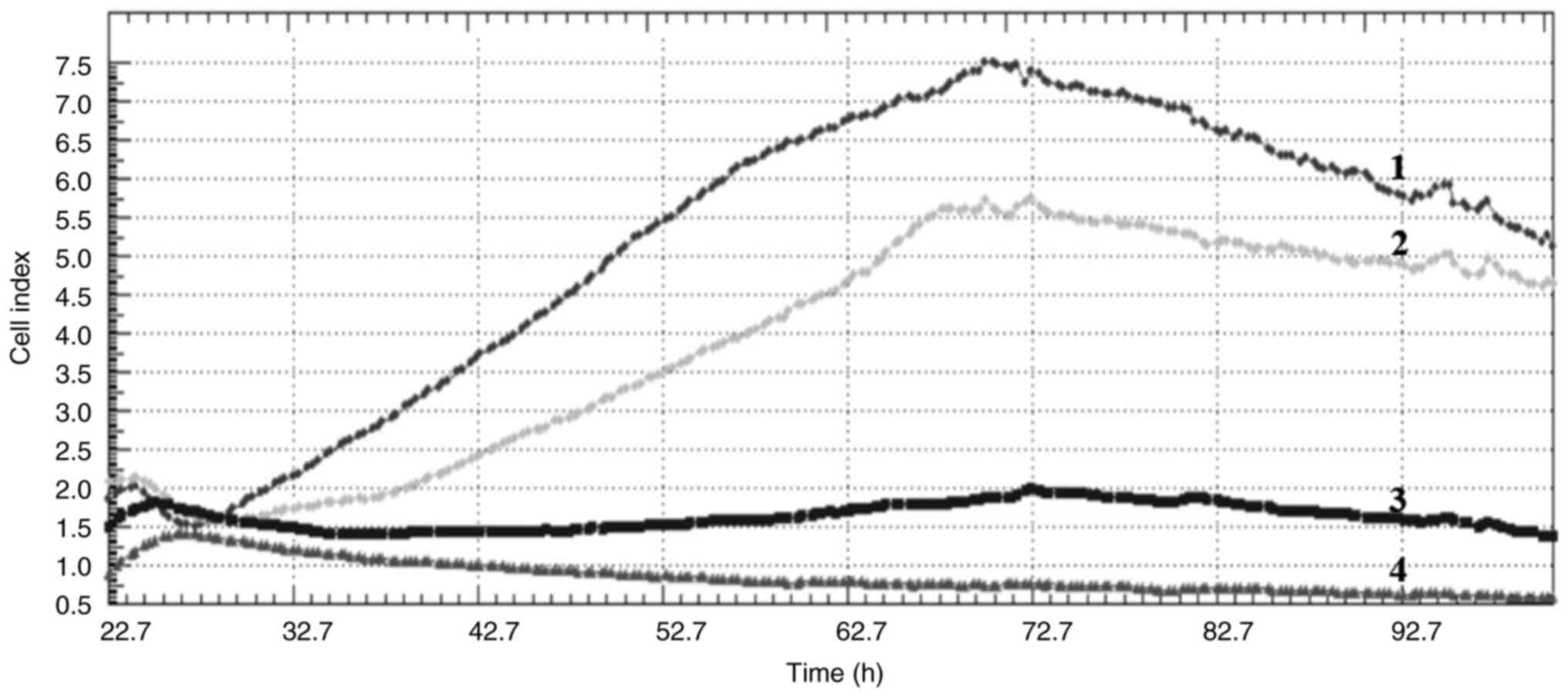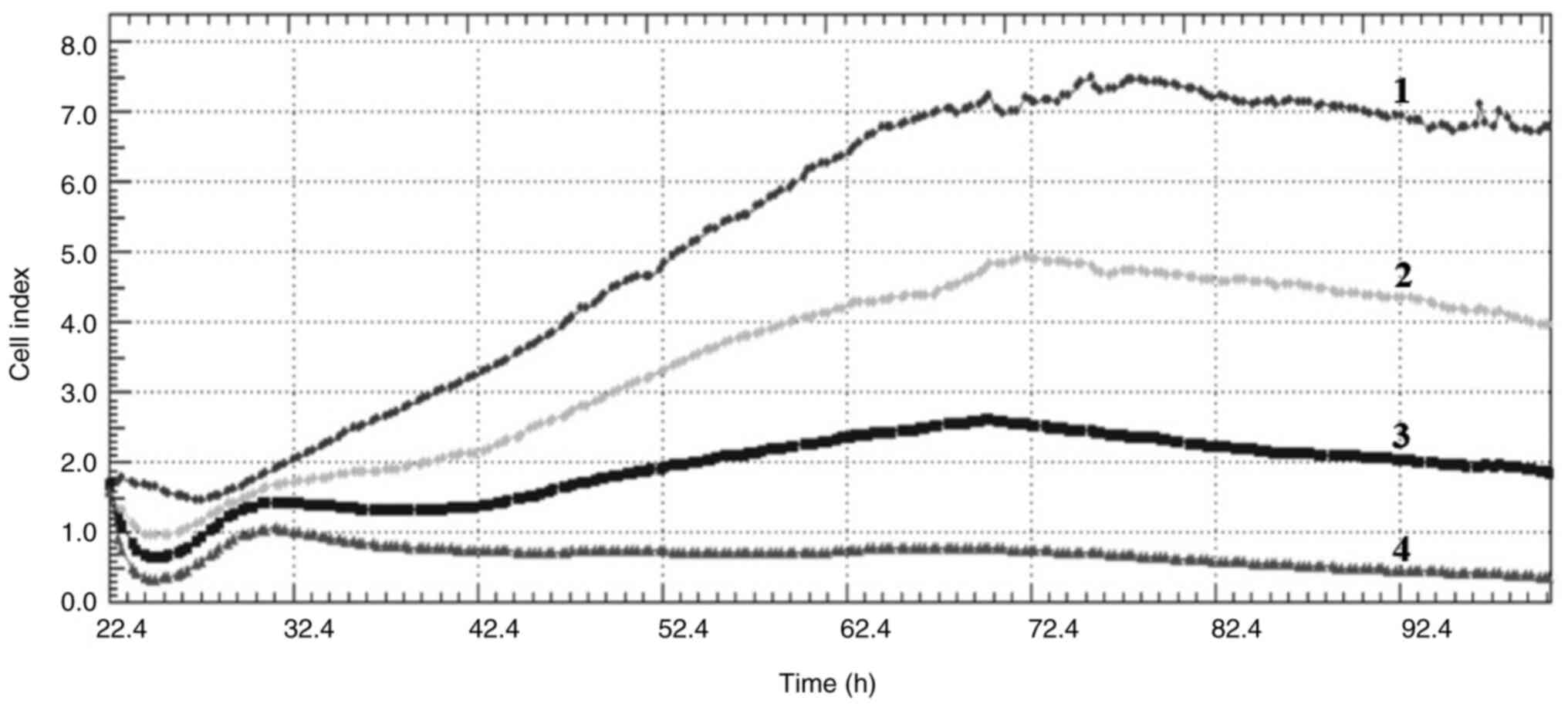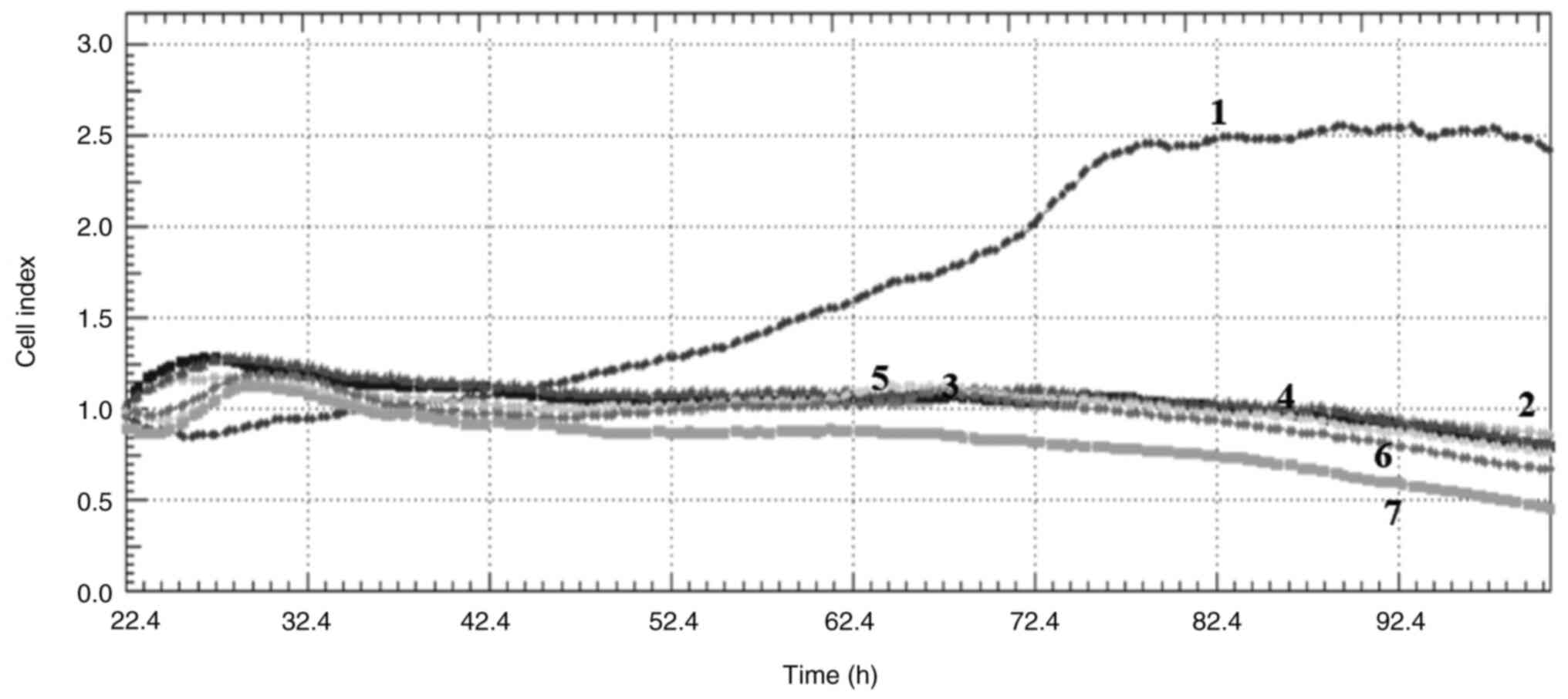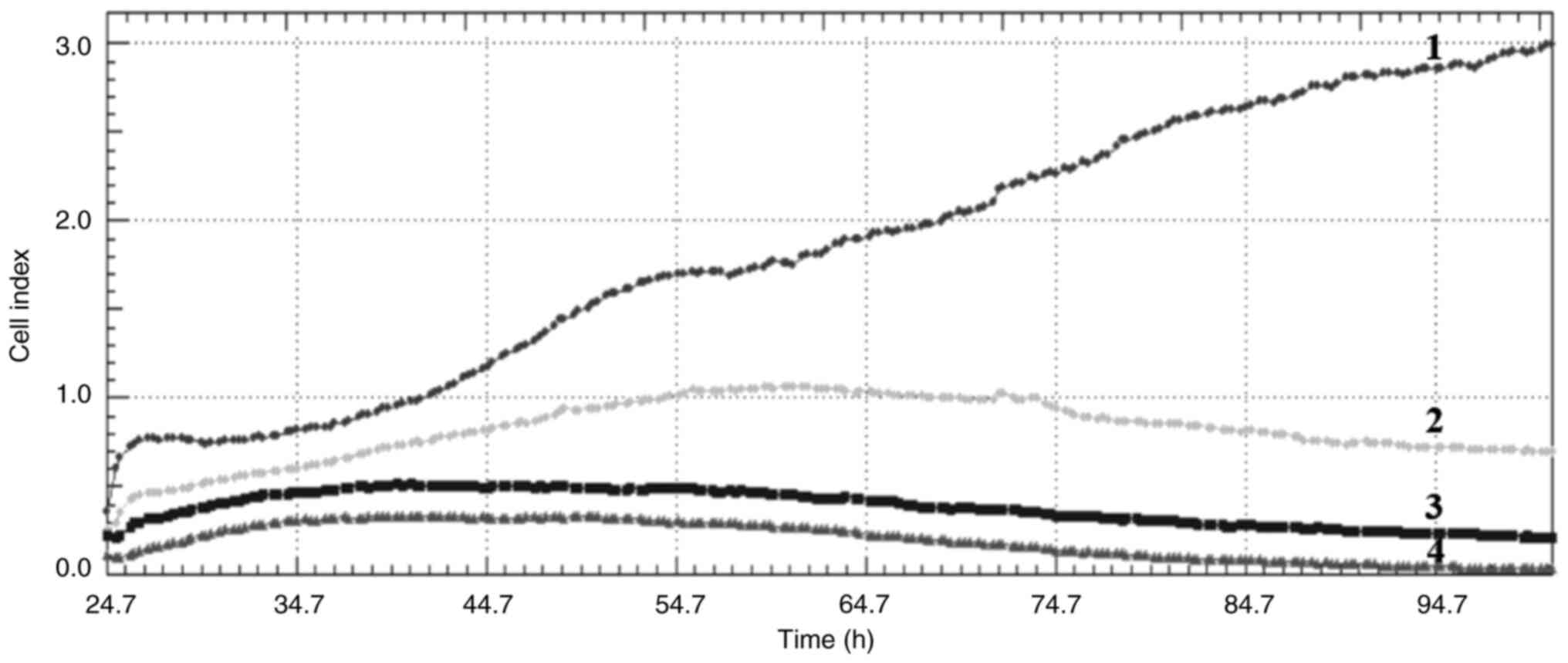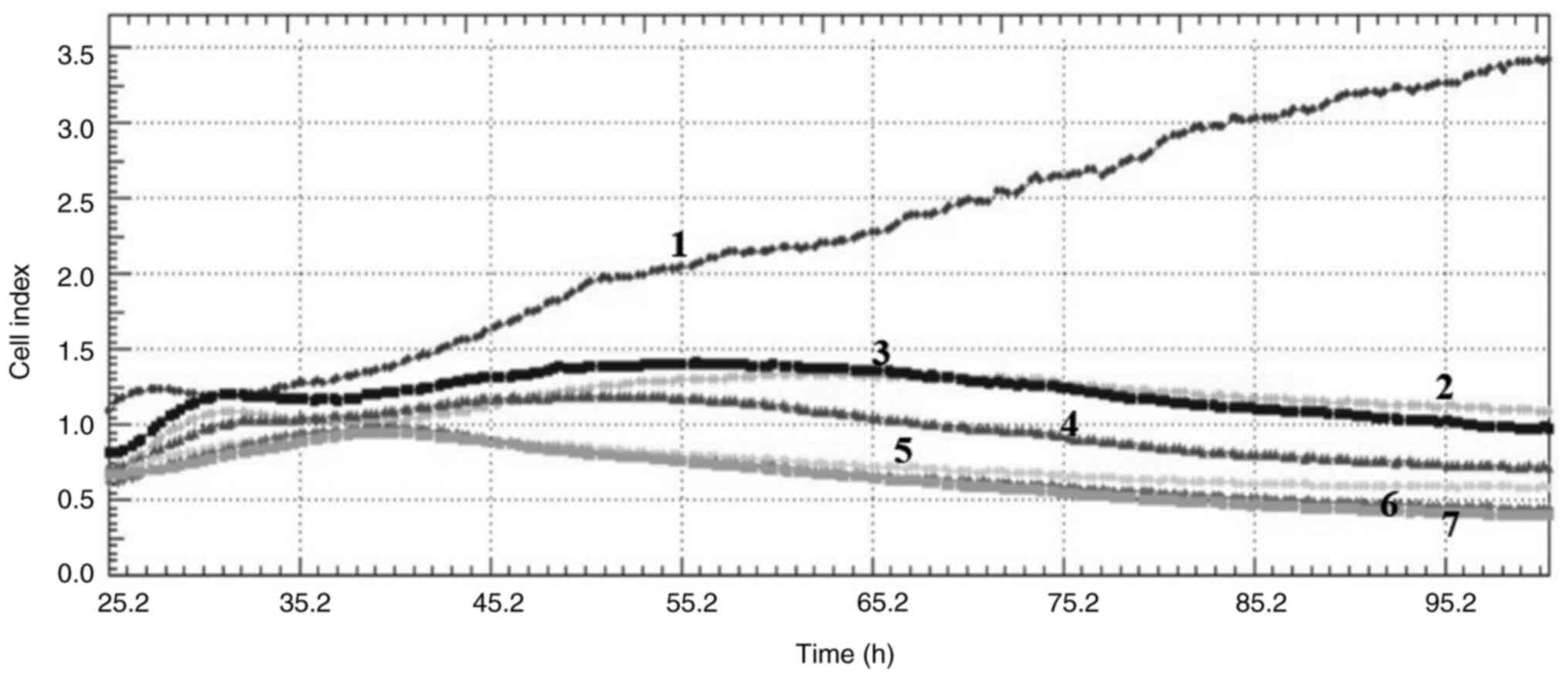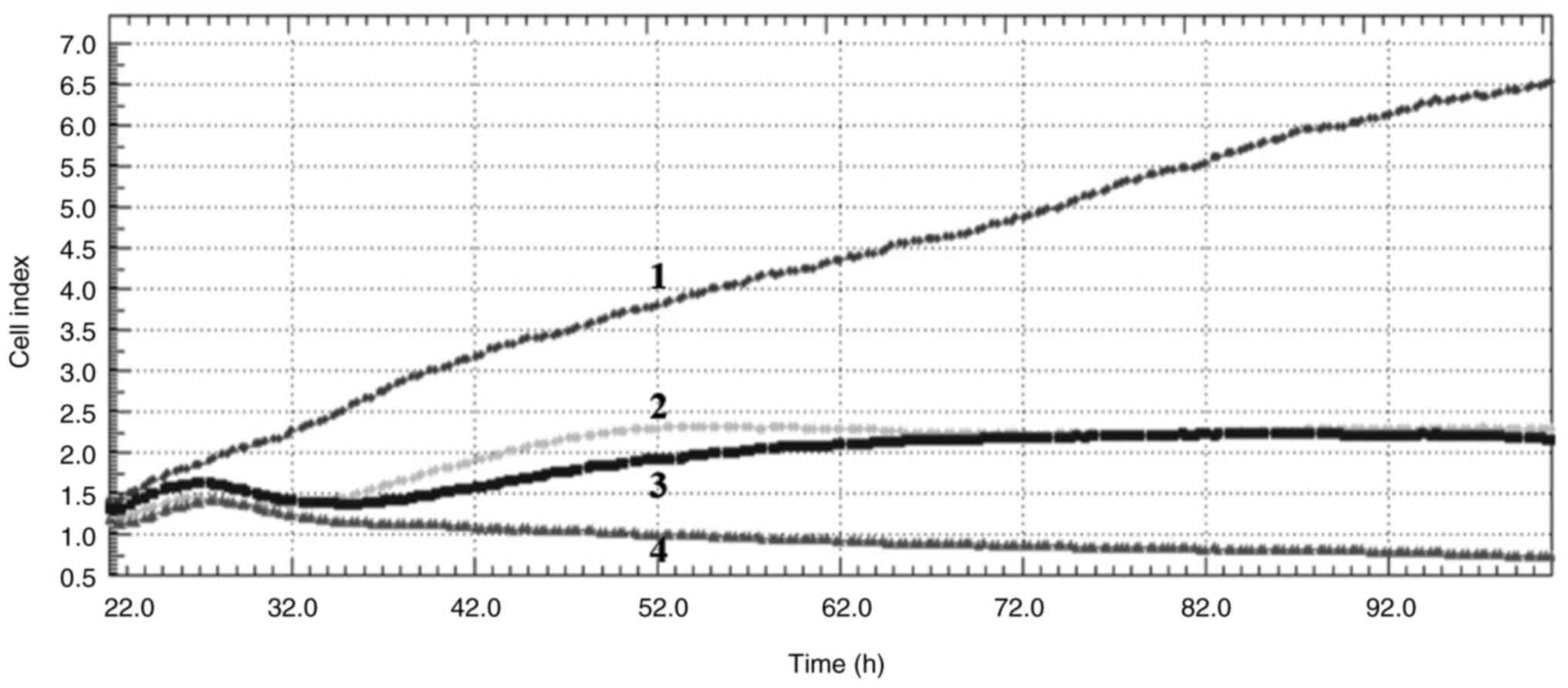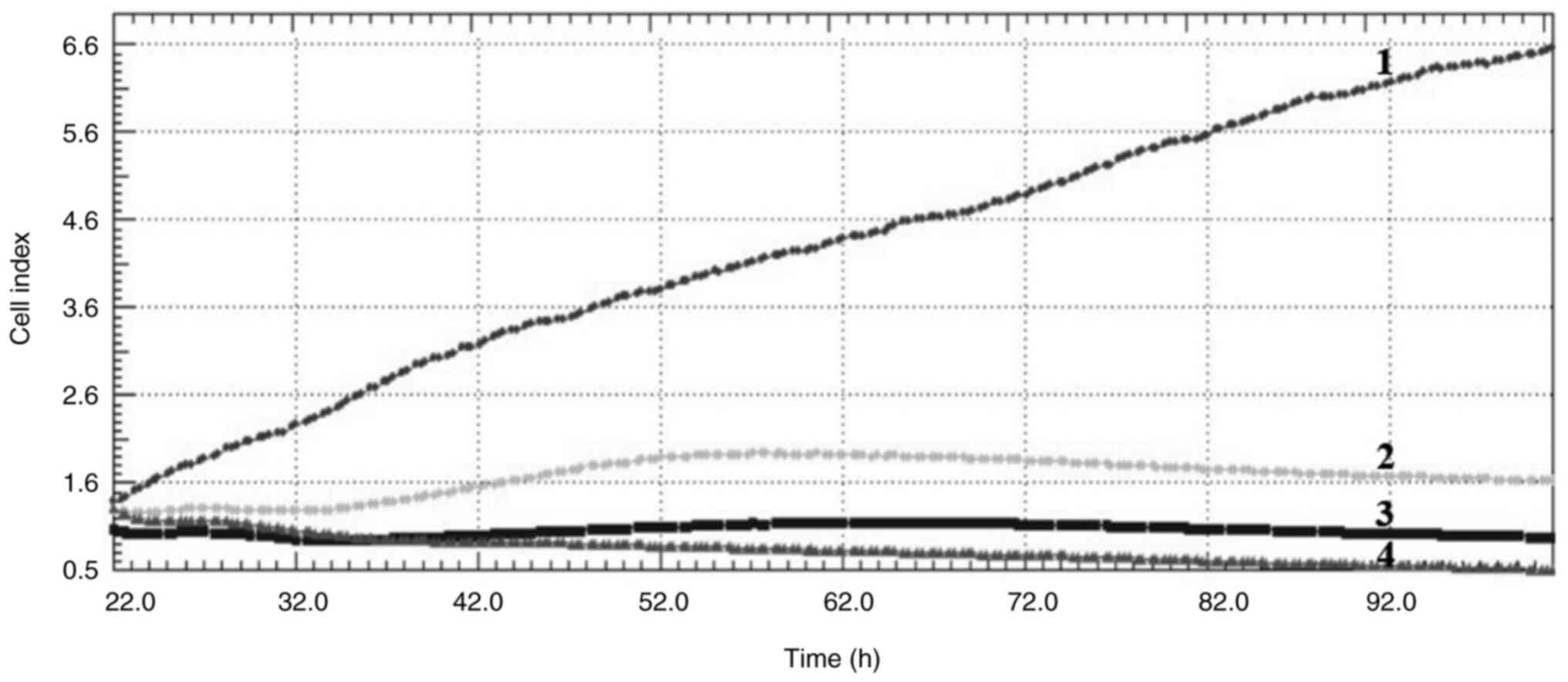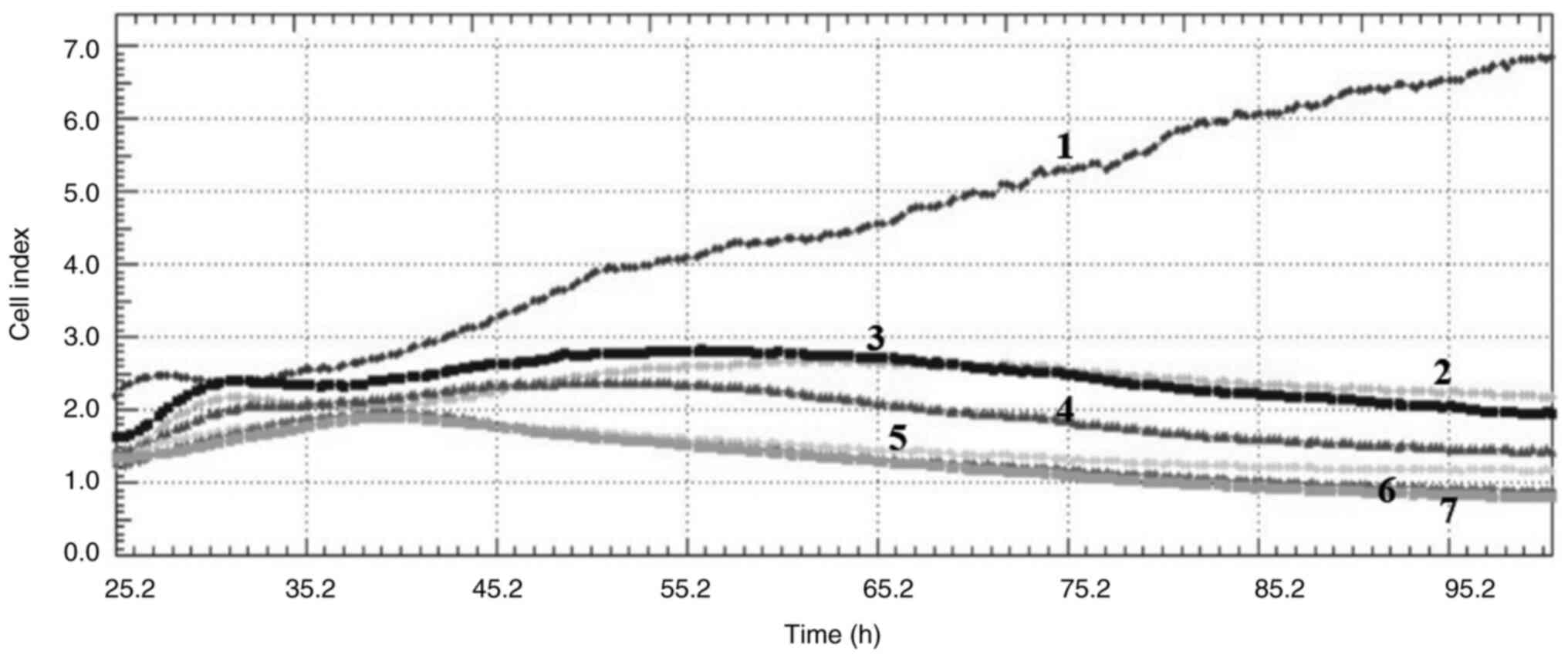Comparison of the effects of crizotinib as monotherapy and as combination therapy with butyric acid on different breast cancer cells
- Authors:
- Published online on: November 1, 2024 https://doi.org/10.3892/ol.2024.14784
- Article Number: 38
Abstract
Introduction
Breast cancer, a heterogeneous disease associated with impaired cell proliferation, is the second most prevalent cause of cancer-related deaths globally and the most common cancer in women (1,2). It is a heterogeneous disease with several morphological and molecular features, as well as clinical outcomes. The majority of breast cancer cases are hormone-dependent, and a positive relationship has been reported between long-term exposure to high concentrations of estrogen and breast cancer incidence (3). However, there are also types of breast cancer that occur and develop independently of hormones. Treatment approaches also differ in breast cancers that differ in terms of formation and development mechanisms (4).
Currently, the parameters used to determine the classification of breast carcinomas are as follows: estrogen receptor (ER) and progesterone receptor (PR), human epidermal growth factor receptor 2 (HER2/cErbB2) overexpression and/or HER2 gene amplification and Ki-67 proliferation index (5). Accordingly, invasive breast carcinoma can be classified as hormone receptor-positive, (HER2)-positive and triple-negative, and these subtypes have their own specific treatment approaches (6–11).
Luminal A is the most common subgroup and constitutes the majority of all breast cancers. Whilst these tumors are ER and/or PR positive, they are HER2 negative. Ki-67 level is also generally <20%. The Luminal A subgroup has the best prognosis of all breast cancers and is generally characterized by low-grade, slow-growing tumors with a high survival rate. Furthermore, relapse rates are lower compared with that of other subgroups (12). In the treatment of hormone receptor-positive breast cancer, selective estrogen receptor modulators (such as tamoxifen and its derivatives) that affect the effect of endogenous estrogens via the receptor, and selective estrogen enzyme modulators (such as formestane and letrozole) that affect the activity of enzymes involved in the synthesis of estrogens, are used (13,14).
HER2-positive tumors constitute 13–20% of invasive breast cancers, and ~50% of them are hormone receptor-negative (11). Whilst the presence of HER2 was used as an indicator of poor prognosis in the past, this view has changed with the use of recombinant humanized anti-HER2 antibody (transtuzumab) (7).
In the triple negative subgroup, all three hormone receptors (ER, PR and HER2) are detected as negative. A distinguishing feature from other subgroups is that it is more common in women aged <40 years and constitutes ~20% of all breast cancers (15).
The majority of cancer drugs used today are tyrosine kinase (TK) inhibitors. This is a family of enzymes involved in signal transduction in human cells. TKs are necessary for normal physiology and regulate signal transduction mechanisms that serve a role in cell homeostasis, cell proliferation, growth arrest and apoptosis. The disruption of these functions causes abnormal cell activity and immunological, neurological, metabolic and infectious diseases, especially cancer. TKIs stop the cell cycle by preventing protein phosphorylation catalyzed by TKs and cause tumor cell apoptosis; it is used in cancer treatment with these effects (16,17). The MET gene (c-MET) encodes a receptor tyrosine kinase (RTK) known as MET (18). A significant factor in the onset and spread of many cancers, including breast cancer, is abnormal MET activation (19,20). Crizotinib acts as a MET inhibitor and crizotinib activity has been reported in patients with MET amplification (21).
Sodium butyrate (SB), as the sodium salt of butyrate, a short-chain fatty acid, causes the activation of genes related to apoptosis due to its histone deacetylase (HDAC) inhibitor (HDACi) activity (22). The HDACi feature, one of the functions of SB, is a subject that has been studied extensively in terms of its effects on tumor formation and development. Acetylated histones form a loose chromatin structure suitable for the transcription initiation complex. In this respect, deacetylation inhibited by SB causes a global increase in transcription (23). It has been reported that SB triggers apoptosis when applied in combination with different molecules such as quercetin (24,25).
The present study aimed to compare the use of Crizotinib as monotherapy and in combination with butyric acid under in vitro conditions using cell lines from different breast cancer types and different cell kinetic parameters, assessing whether the combined use is more effective than its use alone.
Materials and methods
Cell culture
MCF-7, MDA-MB-231 and SKBR-3 were used as different breast cancer models. All cells were adherent cell lines growing in a single layer. The MCF-7 and SKBR3 cell lines were cultured in RPMI-1640 (Gibco; Thermo Fisher Scientific, Inc.) medium containing 2 mM L-glutamine and the MDA-MB-231 cell line was cultured in high glucose DMEM (Gibco; Thermo Fisher Scientific, Inc.). In order for the cells to proliferate, 10% (v/v) fetal calf serum (Gibco; Thermo Fisher Scientific, Inc.) was added to all media. A total of 100 µg/ml streptomycin (streptomycin sulphate; IE Ulugay Ilac Sanayi TAS), 100 IU/ml penicillin (Pronapen; Pfizer, Inc.), amphotericin B (Merck KGaA) were added to the media. All cells were grown at 37°C in a humidified 5% CO2 atmosphere.
Cell index
For all three cell lines, 100 µl medium was added to each well of the 16-well e-plates (special cell culture containers containing microelectrodes). All cells were grown at 37°C in a humidified 5% CO2 atmosphere. Subsequently, cell counting was performed. After the plate was placed in the station, measurements were taken by the device every 15 min and continued until the end of the experiment. A total of 100 µl cells per well were seeded on e-plates, with 10×103 cells for MCF-7, 8×103 cells for SKBR3 and 5×103 cells for MDA MB-231 in each well. After 24 h, the cells were treated with appropriate concentrations of substances (crizotinib: 5, 10 and 15 µM; sodium butyrate: 300, 400 and 500 µM; combined concentrations: 10 µM crizotinib + 50 µM SB, 10 µM crizotinib + 100 µM SB, 10 µM crizotinib + 200 µM SB, 400 µM SB + 2.5 µM crizotinib, 400 µM SB + 5 µM crizotinib and 400 µM SB + 7.5 µM crizotinib) and changes in cell proliferation were observed using the xCELLigence RTCA DP System (Agilent Technologies, Inc.) in the incubator in special cell culture dishes containing microelectrodes.
Bromodeoxyuridine (BrdU) incorporation assay
The Colorimetric BrdU Cell Proliferation Assay Kit (cat. no. 2750; Millipore Sigma) was used to determine the proliferation levels in the MCF-7, MDA-MB-231 and SKBR-3 cells. This method was based on the principle of marking BrdU, which is incorporated into genomic DNA as a thymidine analogue in proliferating cells, using antibody probes and detecting cells in S phase. The BrdU test was performed following the instructions for use provided by the manufacturer. BrdU-labeled cells were evaluated at 370 nm in a microplate reader spectrophotometer.
Mitotic index
Mitotic index values, which demonstrate mitotic activity (the division rate of cells), were evaluated using the Mitotic Assay Kit (cat. no. 18021; Active Motif, Inc.). The mitotic activity assay was performed following the instructions for use provided by the manufacturer. Mitotic cells were evaluated at 450 nm in a microplate reader spectrophotometer within 5 min.
Caspase activity
The CaspaTag Caspase 3,7 In Situ Assay Kit (cat. no. APT403; MilliporeSigma) was used to determine active caspase-3 or −7 in cells undergoing apoptosis. The methodology was based on Fluorochrome Inhibitors of Caspases (26). Caspase activity was performed following the instructions for use provided by the manufacturer, and the activity was assessed at 490 nm excitation wavelength and 520 nm emission wavelength (λex 490, λem 520) using a BioTek Agilent FLx-800 Fluorescent Plate Reader (Agilent Technologies, Inc.).
Statistical analysis
The experiments were performed in three replicates. The data in the present study is presented as the mean ± standard deviation. Comparisons between groups were performed using one-way ANOVA and Dunnett's tests. Statistical evaluations of the cell index were made by the xCelligence device. Dunnett's post hoc test was used for all other parameters. Statistical analyses were reviewed twice in line with referee opinions. Experiments were performed in triplicate. The statistical analyses were performed using SPSS statistics software (v22.0; IBM). P<0.05 was considered to indicate a statistically significant difference.
Results
Cell index
Crizotinib and sodium butyrate were applied alone and in combination at different concentrations on three different cell lines: Crizotinib alone at concentrations of 5, 10 and 15 µM, SB alone at concentrations of 300, 400 and 500 µM, and combined concentrations of 10 µM crizotinib + 50 µM SB, 10 µM crizotinib +100 µM SB, 10 µM crizotinib +200 µM SB, 400 µM SB + 2.5 µM crizotinib, 400 µM SB + 5 µM crizotinib and 400 µM SB + 7.5 µM crizotinib. The cell index was measured for each cell line. Both single and combined applications of crizotinib and sodium butyrate showed cytostatic effects in MCF-7 cell lines (Fig. 1, Fig. 2, Fig. 3, Fig. 4, Fig. 5, Fig. 6, Fig. 7, Fig. 8, Fig. 9).
Mitotic index
The mitotic index values obtained following the application of crizotinib and SB alone and in combination to MCF-7, MDA-MB-231 and SKBR-3 cells are presented in Table I. As a result of the mitotic index application of critotinib and SB alone and in combination, mitotic index values in all cell lines decreased significantly over time, in comparison with the control (P<0.05). Moreover, the drug combinations were more successful in reducing the mitotic index values than single applications and were associated with a greater decline in cell proliferation.
BrdU cell proliferation test (labelling index)
The labeling index values obtained following the application of crizotinib and SB alone and in combination to MCF-7, MDA-MB-231 and SKBR-3 cells are presented in Table II. As a result of the BrdU cell proliferation application of critotinib and SB alone and in combination, labeling index values in all cell lines decreased significantly over time, in comparison with the control (P<0.05). Moreover, the drug combinations were more successful in reducing the labeling index values compared with that of the single applications and were associated with blockages in the synthesis phase of the cells.
Caspase activity
The caspase activity values obtained following the application of crizotinib and SB alone and in combination to MCF-7, MDA-MB-231 and SKBR-3 cells are presented in Table III. As a result of the caspase activity application of critotinib and SB alone and in combination, caspase activity values in all cell lines increased significantly over time, compared with the control (P<0.05). Furthermore, the drug combinations were associated with a greater increase in caspase activity compared with that of the single applications, and this caused the cells to undergo apoptosis.
Discussion
In the present study, the effectiveness of crizotinib as a monotherapy and when used with SB, which acts as a HDACi, was evaluated in different types of breast cancer cell lines.
Although there are different treatment approaches in cancer treatment, a single definitive treatment method cannot be focused on as each method has its own advantages and disadvantages, cancer is a disease specific to each individual, and treatments may differ from person to person (27). Furthermore, combination treatments, which have many advantages over monotherapy applications, are important in increasing treatment response and reducing drug resistance (28). The combination therapy approach allows the use of lower doses than monotherapy applications. Therefore, it increases the effectiveness of treatment and reduces the toxicity caused by high doses (29).
RTKs are associated with the development and progression of most types of cancer in humans (30). Therefore, targeting RTKs has become a therapeutic target for the treatment of cancer (30–32). Among RTKs, MET serves an important role during tumor development and progression (33,34). High levels of MET in breast cancer have been associated with a high tumor grade and poor prognosis (35–37). Results from clinical studies have associated MET overexpression with increased recurrence rates and decreased survival in patients with breast cancer (38,39). Furthermore, tissue microarray analyses and expression data have reported associations of MET overexpression with basal and ER/HER2-negative forms of breast cancer in humans (32,35,38–40). Animal experiments have also reported that MET activation induces mammary tumors with different characteristics (38,39).
The therapeutic use of anti-MET drugs has attracted interest due to the possible role of the hepatocyte growth factor/MET axis in the development of breast carcinomas and other malignancies (31,41). Studies have reported the development and assessment of small molecule MET tyrosine kinase inhibitors as a monotherapy or in combination with other targeted medicines (42). Anaplastic lymphoma kinase, receptor tyrosine kinase C-Ros oncogene 1 and MET are all targets of the multitarget RTK inhibitor crizotinib (43,44).
MET activation promotes cancer cell spread, migration and invasion (45). The findings from the present study with MDA-MB-231 cells demonstrated crizotinib administration dose-dependently inhibited the proliferation of these cells. Moreover, decreased MET activation may explain the anti-proliferative, anti-migratory and anti-invasive effects of crizotinib in triple-negative breast cancer (46).
Furthermore, it has been reported that MET overexpression is associated with decreased treatment sensitivity in different cancer types (47–50). Therefore, it may be beneficial to use crizotinib together with different therapeutic targets to increase treatment sensitivity (46).
SB is a short-chain fatty acid and a byproduct of carbohydrate metabolism in the intestine and. It is considered a potent HDACi that has emerged as an anticancer agent for certain cancers (51). Studies with SB have reported that it is associated with a reduction in the rate of breast cancer cells depending on dose and time (52,53). The inhibitory effect of SB on hormone-dependent and independent cell lines, and its ability to induce apoptosis through cell cycle disruption in hormone-dependent cell lines, suggests that it may have important implications for the treatment of human tumors, including breast cancer (53). Stockhammera et al (54) reported that HDAC inhibition sensitized highly resistant PF240-PE tumor cells to crizotinib and may overcome treatment resistance. Moreover, Fukuda et al (55) reported that the HDACi quinostat induced mesenchymal-epithelial transition by reducing zinc finger E-Box binding homeobox 1 expression in clones in vitro and therefore, restoring sensitivity to crizotinib.
The results of the present study, in which crizotinib was used together with a HDACi, are important in terms of creating more effective treatment strategies in different molecular subtypes of breast cancer when crizotinib is used with different therapeutic targets. The results demonstrated that combined applications, in which the concentrations of both crizotinib and SB were reduced, resulted in more effective results in different cell kinetic parameters than monotherapy applications. This is important in terms of reducing the side effects of the drugs used and reducing treatment resistance. Furthermore, when evaluated clinically, the results of the present study suggest that the MET inhibitor crizotinib may be more effective in breast cancers with different molecular subtypes when used together with SB. However, the absence of healthy breast cells in the present study makes it difficult to estimate clinical efficacy, as it could not be observed at which dose ranges the combined applications would cause toxic effects.
Acknowledgements
Not applicable.
Funding
The present study was supported by the Scientific Research Projects Coordination Unit of Istanbul University (grant no. FBA-2022-38767).
Availability of data and materials
The data generated in the present study may be requested from the corresponding author.
Authors' contributions
MT, İÇ, EP and MÇ performed the experiments. MT, İÇ, EP and MÇ wrote and edited the manuscript. All authors confirm the authenticity of all the raw data. All authors have read and approved the final version of the manuscript.
Ethics approval and consent to participate
Not applicable.
Patient consent for publication
Not applicable.
Competing interests
The authors declare that they have no competing interests.
References
|
Arya GC, Kaur K and Jaitak V: Isoxazole derivatives as anticancer agent: A review on synthetic strategies, mechanism of action and SAR studies. Eur J Med Chem. 221:1135112021. View Article : Google Scholar : PubMed/NCBI | |
|
Siegel RL, Miller KD and Jemal A: Cancer statistics, 2019. CA Cancer J Clin. 69:7–34. 2019. View Article : Google Scholar : PubMed/NCBI | |
|
Yue W, Yager JD, Wang JP, Jupe ER and Santen RJ: Estrogen receptor-dependent and independent mechanisms of breast cancer carcinogenesis. Steroids. 78:161–170. 2013. View Article : Google Scholar : PubMed/NCBI | |
|
İnce E and Orhan HG: Estrogen-Induced Breast Cancer, Therapeutical Approaches and the Role of Melatonin in Treatment. HUJPHARM. 39:113–128. 2019.(In Türkiye). | |
|
Sørlie T, Perou CM, Tibshirani R, Aas T, Geisler S, Johnsen H, Hastie T, Eisen MB, van de Rijn M, Jeffrey SS, et al: Gene expression patterns of breast carcinomas distinguish tumor subclasses with clinical implications. Proc Natl Acad Sci USA. 98:10869–10874. 2001. View Article : Google Scholar : PubMed/NCBI | |
|
Herschkowitz JI, Simin K, Weigman VJ, Mikaelian I, Usary J, Hu Z, Rasmussen KE, Jones LP, Assefnia S, Chandrasekharan S, et al: Identification of conserved gene expression features between murine mammary carcinoma models and human breast tumors. Genome Biol. 8:R762007. View Article : Google Scholar : PubMed/NCBI | |
|
Huang E, Cheng SH, Dressman H, Pittman J, Tsou MH, Horng CF, Bild A, Iversen ES, Liao M, Chen CM, et al: Gene expression predictors of breast cancer outcomes. Lancet. 361:1590–1596. 2003. View Article : Google Scholar : PubMed/NCBI | |
|
Sørlie T, Tibshirani R, Parker J, Hastie T, Marron JS, Nobel A, Deng S, Johnsen H, Pesich R, Geisler S, et al: Repeated observation of breast tumor subtypes in independent gene expression data sets. Proc Natl Acad Sci USA. 100:8418–8423. 2003. View Article : Google Scholar : PubMed/NCBI | |
|
Peng JH, Zhang X, Song JL, Ran L, Luo R, Li HY and Wang YH: Neoadjuvant chemotherapy reduces the expression rates of ER, PR, HER2, Ki67 and P53 of invasive ductal carcinoma. Medicine (Baltimore). 98:e135542019. View Article : Google Scholar : PubMed/NCBI | |
|
Barnes DM and Hanby AM: Oestrogen and progesterone receptors in breast cancer: past, present and future. Histopathology. 38:271–274. 2001. View Article : Google Scholar : PubMed/NCBI | |
|
Akoz G, Diniz G, Ekmekci S, Ekin ZY and Uncel M: Evaluation of human epididymal secretory protein 4 expression according to the molecular subtypes (luminal A, luminal B, human epidermal growth factor receptor 2-positive, triple-negative) of breast cancer. Indian J Pathol Microbiol. 61:323–329. 2018. View Article : Google Scholar : PubMed/NCBI | |
|
Orrantia-Borunda E, Anchondo-Nuñez P, Acuña-Aguilar LE, Gómez-Valles FO, Ramírez-Valdespino CA and Mayrovitz HN: Subtypes of Breast Cancer. Exon Publications 31–42; 2022, View Article : Google Scholar | |
|
Barker S: Anti-estrogens in the treatment of breast cancer: current status and future directions. Curr Opin Investig Drugs. 4:652–657. 2003.PubMed/NCBI | |
|
Wong ZW and Ellis MJ: First-line endocrine treatment of breast cancer: Aromatase inhibitor or antioestrogen? Br J Cancer. 90:20–25. 2004. View Article : Google Scholar : PubMed/NCBI | |
|
Kumar P and Aggarwal R: An overview of triple-negative breast cancer. Arch Gynecol Obstet. 293:247–269. 2016. View Article : Google Scholar : PubMed/NCBI | |
|
Hong S, Fang W, Liang W, Yan Y, Zhou T, Qin T, Wu X, Ma Y, Zhao Y, Yang Y, et al: Risk of treatment-related deaths with vascular endothelial growth factor receptor tyrosine kinase inhibitors: A meta-analysis of 41 randomized controlled trials. Onco Targets Ther. 7:1851–1867. 2014. View Article : Google Scholar : PubMed/NCBI | |
|
Gurkan-Alp SA and Bozca F: Tirozin kinaz enzim inhibitörü yeni bileşikler ve yapı aktivite ilişkilerinin değerlendirilmesi. FABAD J Pharm Sci. 44:65–78. 2019. | |
|
De Bono JS and Yap TA: c-MET: An exciting new target for anticancer therapy. Ther Adv Med Oncol. 3 (Suppl. S1):S3–S5. 2011. View Article : Google Scholar : PubMed/NCBI | |
|
Gastaldi S, Comoglio PM and Trusolino L: The Met oncogene and basal-like breast cancer: Another culprit to watch out for? Breast Cancer Res. 12:2082010. View Article : Google Scholar : PubMed/NCBI | |
|
Ho-Yen CM, Jones JL and Kermorgant S: The clinical and functional significance of c-Met in breast cancer: A review. Breast Cancer Res. 17:522015. View Article : Google Scholar : PubMed/NCBI | |
|
Mino-Kenudson M, Chirieac LR, Law K, Hornick JL, Lindeman N, Mark EJ, Cohen DW, Johnson BE, Jänne PA, Iafrate AJ and Rodig SJ: A novel highly sensitive antibody allows for the routine detection of ALK rearranged lung adenocarcinomas by standard immunohistochemistry. Clin Cancer Res. 16:1561–1571. 2010. View Article : Google Scholar : PubMed/NCBI | |
|
Hagland HR and Søreide K: Cellular metabolism in colorectal carcinogenesis: Influence of lifestyle, gut microbiome and metabolic pathways. Cancer Lett. 356:273–280. 2015. View Article : Google Scholar : PubMed/NCBI | |
|
Hamer HM, Jonkers D, Venema K, Vanhoutvin S, Troost FJ and Brummer RJ: Review article: The role of butyrate on colonic function. Aliment Pharmacol Ther. 27:104–119. 2008. View Article : Google Scholar : PubMed/NCBI | |
|
Taylor MA, Khathayer F and Ray SK: Quercetin and sodium butyrate synergistically increase apoptosis in rat C6 and Human T98G glioblastoma cells through inhibition of autophagy. Neurochem Res. 44:1715–1725. 2019. View Article : Google Scholar : PubMed/NCBI | |
|
Egler V, Korur S, Failly M, Boulay JL, Imber R, Lino MM and Merlo A: Histone deacetylase inhibition and blockade of the glycolytic pathway synergistically induce glioblastoma cell death. Clin Cancer Res. 14:3132–3140. 2008. View Article : Google Scholar : PubMed/NCBI | |
|
Pulat E and Topçul MR: Effects of combined use of ribociclib with PARP1 inhibitor on cell kinetics in breast cancer. Oncol Lett. 27:2432024. View Article : Google Scholar : PubMed/NCBI | |
|
Baykara O: Kanser Tedavisinde Güncel YaklaşImlar. Balıkesir Sağlık Bilimleri Dergisi. 5:154–165. 2016.(In Türkiye). | |
|
Palmer AC and Sorger PK: Combination cancer therapy can confer benefit via patient-to-patient variability without drug additivity or synergy. Cell. 171:1678–1691.e13. 2017. View Article : Google Scholar : PubMed/NCBI | |
|
Lee JH and Nan A: Combination drug delivery approaches in metastatic breast cancer. J Drug Deliv. 2012:9153752012. View Article : Google Scholar : PubMed/NCBI | |
|
Takeuchi K and Ito F: Receptor tyrosine kinases and targeted cancer therapeutics. Biol Pharm Bull. 34:1774–1780. 2011. View Article : Google Scholar : PubMed/NCBI | |
|
Zhu K, Kong X, Zhao D, Liang Z and Luo C: c-MET kinase inhibitors: A patent review (2011–2013). Expert Opin Ther Pat. 24:217–230. 2014. View Article : Google Scholar : PubMed/NCBI | |
|
Linklater ES, Tovar EA, Essenburg CJ, Turner L, Madaj Z, Winn ME, Melnik MK, Korkaya H, Maroun CR, Christensen JG, et al: Targeting MET and EGFR crosstalk signaling in triple-negative breast cancers. Oncotarget. 7:69903–69915. 2016. View Article : Google Scholar : PubMed/NCBI | |
|
Blumenschein GR Jr, Mills GB and Gonzalez-Angulo AM: Targeting the hepatocyte growth factor-cMET axis in cancer therapy. J Clin Oncol. 30:3287–3296. 2012. View Article : Google Scholar : PubMed/NCBI | |
|
Boccaccio C and Comoglio PM: MET, a driver of invasive growth and cancer clonal evolution under therapeutic pressure. Curr Opin Cell Biol. 31:98–105. 2014. View Article : Google Scholar : PubMed/NCBI | |
|
Gonzalez-Angulo AM, Chen H, Karuturi MS, Chavez-MacGregor M, Tsavachidis S, Meric-Bernstam F, Do KA, Hortobagyi GN, Thompson PA, Mills GB, et al: Frequency of mesenchymal-epithelial transition factor gene (MET) and the catalytic subunit of phosphoinositide-3-kinase (PIK3CA) copy number elevation and correlation with outcome in patients with early stage breast cancer. Cancer. 119:7–15. 2013. View Article : Google Scholar : PubMed/NCBI | |
|
Inanc M, Ozkan M, Karaca H, Berk V, Bozkurt O, Duran AO, Ozaslan E, Akgun H, Tekelioglu F and Elmali F: Cytokeratin 5/6, c-Met expressions, and PTEN loss prognostic indicators in triple-negative breast cancer. Med Oncol. 31:8012014. View Article : Google Scholar : PubMed/NCBI | |
|
Yan S, Jiao X, Zou H and Li K: Prognostic significance of c-Met in breast cancer: A metaanalysis of 6010 cases. Diagn Pathol. 10:622015. View Article : Google Scholar : PubMed/NCBI | |
|
Ponzo MG, Lesurf R, Petkiewicz S, O'Malley FP, Pinnaduwage D, Andrulis IL, Bull SB, Chughtai N, Zuo D, Souleimanova M, et al: Met induces mammary tumors with diverse histologies and is associated with poor outcome and human basal breast cancer. Proc Natl Acad Sci USA. 106:12903–12908. 2009. View Article : Google Scholar : PubMed/NCBI | |
|
Graveel CR, DeGroot JD, Su Y, Koeman J, Dykema K, Leung S, Snider J, Davies SR, Swiatek PJ, Cottingham S, et al: Met induces diverse mammary carcinomas in mice and is associated with human basal breast cancer. Proc Natl Acad Sci USA. 106:12909–12914. 2009. View Article : Google Scholar : PubMed/NCBI | |
|
Sierra JR and Tsao MS: c-MET as a potential therapeutic target and biomarker in cancer. Ther Adv Med Oncol 3 (1 suppl). S21–S35. 2011. View Article : Google Scholar : PubMed/NCBI | |
|
Huang X, Li E, Shen E, Wang X, Tang T, Zhang X, Xu J, Tang Z, Guo C, Bai X and Liang T: Targeting the HGF/MET axis in cancer therapy: Challenges in resistance and opportunities for improvement. Front Cell Dev Biol. 8:1522020. View Article : Google Scholar : PubMed/NCBI | |
|
Goździk-Spychalska J, Szyszka-Barth K, Spychalski Ł, Ramlau K, Wójtowicz J, Batura-Gabryel H and Ramlau R: C-MET inhibitors in the treatment of lung cancer. Curr Treat Options Oncol. 15:670–682. 2014. View Article : Google Scholar : PubMed/NCBI | |
|
Kwak EL, Bang YJ, Camidge DR, Shaw AT, Solomon B, Maki RG, Ou SH, Dezube BJ, Jänne PA, Costa DB, et al: Anaplastic lymphoma kinase inhibition in non-small-cell lung cancer. N Engl J Med. 363:1693–1703. 2010. View Article : Google Scholar : PubMed/NCBI | |
|
Cui JJ, Tran-Dubé M, Shen H, Nambu M, Kung PP, Pairish M, Jia L, Meng J, Funk L, Botrous I, et al: Structure based drug design of crizotinib (PF02341066), a potent and selective dual inhibitor of mesenchymal-epithelial transition factor (c-MET) kinase and anaplastic lymphoma kinase (ALK). J Med Chem. 54:6342–6363. 2011. View Article : Google Scholar : PubMed/NCBI | |
|
Lawrence RE and Salgia R: MET molecular mechanisms and therapies in lung cancer. Cell Adh Migr. 4:146–152. 2010. View Article : Google Scholar : PubMed/NCBI | |
|
Ayoub NM, Al-Shami KM, Alqudah MA and Mhaidat NM: Crizotinib, a MeT inhibitor, inhibits growth, migration, and invasion of breast cancer cells in vitro and synergizes with chemotherapeutic agents. Onco Targets Ther. 10:4869–4883. 2017. View Article : Google Scholar : PubMed/NCBI | |
|
Du Y, Yamaguchi H, Wei Y, Hsu JL, Wang HL, Hsu YH, Lin WC, Yu WH, Leonard PG, Lee GR IV, et al: Blocking c-Met-mediated PARP1 phosphorylation enhances anti-tumor effects of PARP inhibitors. Nat Med. 22:194–201. 2016. View Article : Google Scholar : PubMed/NCBI | |
|
Raghav KP, Gonzalez-Angulo AM and Blumenschein GR Jr: Role of HGF/MET axis in resistance of lung cancer to contemporary management. Transl Lung Cancer Res. 1:179–193. 2012.PubMed/NCBI | |
|
Wang J and Cheng JX: c-Met inhibition enhances chemosensitivity of human ovarian cancer cells. Clin Exp Pharmacol Physiol. 44:79–87. 2017. View Article : Google Scholar : PubMed/NCBI | |
|
Li E, Hu Z, Sun Y, Zhou Q, Yang B, Zhang Z and Cao W: Small molecule inhibitor of c-Met (PHA665752) suppresses the growth of ovarian cancer cells and reverses cisplatin resistance. Tumour Biol. 37:7843–7852. 2016. View Article : Google Scholar : PubMed/NCBI | |
|
Natoni F, Diolordi L, Santoni C and Gilardini Montani MS: Sodium butyrate sensitises human pancreatic cancer cells to both the intrinsic and the extrinsic apoptotic pathways. Biochim Biophys Acta. 1745:318–329. 2005. View Article : Google Scholar : PubMed/NCBI | |
|
Salimi V, Shabani M, Nourbakhsh M and Tavakoli-Yaraki M: Involvement of 15-lipoxygenase-1 in the regulation of breast cancer cell death induced by sodium butyrate. Cytotechnology. 68:2519–2528. 2016. View Article : Google Scholar : PubMed/NCBI | |
|
Coradini D, Biffi A, Costa A, Pellizzaro C, Pirronello E and Di Fronzo G: Effect of sodium butyrate on human breast cancer cell lines. Cell Prolif. 30:149–159. 1997. View Article : Google Scholar : PubMed/NCBI | |
|
Stockhammera P, Hoc CSL, Hegedusa L, Lotzd G, Molnárd E, Bankfalvie A, Herold T, Kalbourtzis S, Ploenes T, Eberhardt WEE, et al: HDAC inhibition synergizes with ALK inhibitors to overcome resistance in a novel ALK mutated lung adenocarcinoma model. Lung Cancer. 144:20–29. 2020. View Article : Google Scholar : PubMed/NCBI | |
|
Fukuda K, Takeuchi S, Katayama R, Nanjo S, Yamada T, Suzuki T, et al: HDAC Inhibition Overcomes Crizotinib-Resistance by Mesenchymal-Epithelial Transition (MET) in EML4-ALK Lung Cancer Cells. J Thorac Oncol. 12:S382–S383. 2017. View Article : Google Scholar |



